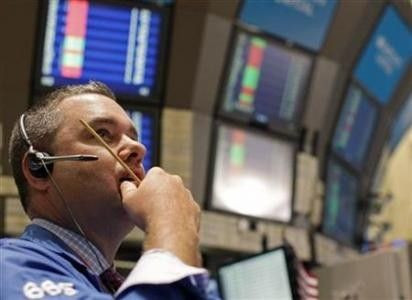Death Cross Rocks Wall Street

Before the stormy trading of August, many stock investors probably thought death cross was the name of some heavy metal band.
But after a period in which the S&P 500 plunged more than 15 percent, daily trading volumes spiked by 70 percent and the United States lost its vaunted 'triple-A' rating, a death cross and other technical analysis terms are something investors have had to become increasingly familiar with.
For chartists and market technicians, the death cross is a strong bearish signal that indicates a major shift in trading momentum.
In the case of the S&P 500, a death cross occurs when the 50-day average for the index sinks below, or crosses over, its 200-day average. (Graphic: r.reuters.com/baq33s)
There was a time on Wall Street when many regarded technical analysis as something akin to voodoo economics, especially among stock pickers who specialized in fundamental research. But with algorithimic trading all the rage, it appears that cold and dispassionate technical market analysis is coming of age.
The recent market plunge which took the S&P 500 to about 1,100 is a prime of example of why more traders are looking to technical analysis for guidance. That's because many computer-driven trading programs are pegged to buy and sell stocks when certain market levels are breached.
Computers fire off automatically; you don't have the time lag you'd have in normal decision making, says Marc Pado, U.S. technical market strategist at Cantor Fitzgerald & Co. Clearly this is not stock picking (but) indiscriminate buying and selling.
Pado says the selling all started when the S&P 500 broke through the 200-day moving average and a support level of 1,250 on the index. He says, that started the capitulation to the downside that we saw in the market overall.
The beauty (or flaw) of technical analysis is that it tells traders when to buy or sell without regard to corporate earnings or arguments over how to solve Europe's sovereign debt woes. So the silver lining of a precipitous drop in stocks is that it could be a signal for markets to go up.
By selling off, the market is now discounting the bad news, said Carter Worth, chief market technician at Oppenheimer & Co in New York.
Another factor technical analysis focuses on is volatility and there has been a lot of that lately. In fact, one measure of volatility doubled in three days and on August 8, when the S&P 500 fell 6.66 percent, the volatility index closed at its highest level since the market bottomed in March 2009. (Graphic: r.reuters.com/qeq33s)
It highlights how extreme, how one-sided it was, said Craig Peskin, co-head of technical analysis research at MF Global in New York, who noted that every stock in the S&P 500 declined on August 8. Everyone was treating everything equally.
Some likened what they were seeing in the market to last year's flash crash, when the Dow Jones Industrials plunged nearly 1,000 points in 20 minute. Except this time, it appears to be a flash crash in slow motion.
We were moving over a three and a half day period like we were during the flash crash, just more orderly, Peskin said. It was totally irrational.
In fact, the week of August 8 was so extreme it even left some technical analysts scratching their heads at the unusual up and down trading. On August 9, stocks roared back, with the S&P 500 gaining 4.74 percent and almost wiping out the prior day's losses. Meanwhile, the Dow industrials would experience six days trading in swings of more than 400 points.
I don't have an exact answer on how to label that pattern from a technical perspective because the volatility was so extreme, said MF Global's Peskin.
Many market participants say this volatility is not going to go away. It is a new normal that makes technical analysis a key rule of the game - even if some dismiss it as market astrology and don't want to play.
There are also new opportunities, if traders have the stomach and the correct analysis tools -- and know how to use them.
High-frequency traders are moving the markets based on price action, based on momentum - they don't really care what they're trading, said Bill Stone, chief strategist for PNC Wealth Management.
They don't care about intrinsic value, they care about some pattern. So you have days like last week where you get whipsawed 5 and 6 percent from day to day, he said. Those days can be scary, but they are also your opportunity because they are driving (lower) companies that have no reason to be falling so far.
© Copyright Thomson Reuters 2024. All rights reserved.




















